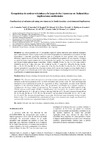Please use this identifier to cite or link to this item:
https://accedacris.ulpgc.es/jspui/handle/10553/9926
| Title: | Geoquímica de cenizas volcánicas a lo largo de dos transectas en Sudamérica: implicaciones ambientales | Other Titles: | Geochemistry of volcanic ash along two transects in South America: environmental implications | Authors: | Fernández Turiel, J. L. Saavedra, J. Gimeno Torrente, Domingo Ruggieri, F. Perez-Torrado, Francisco-Jose Rodriguez-Gonzalez, Alejandro Martínez, Luis D. Gil, R. García Valles, M. T. Polanco, E. Galindo, G. |
UNESCO Clasification: | 250621 Vulcanología | Keywords: | Ceniza volcánica Lixiviación batch Lixiviación en columna Elementos traza Andes, et al |
Issue Date: | 2012 | Abstract: | La ceniza generada por el volcanismo explosivo aporta nutrientes pero también elementos traza potencialmente tóxicos a gran escala a los ciclos biogeoquímicos continentales y oceánicos. Se han desarrollado e innovado protocolos analíticos para la evaluación de estos aportes sobre cenizas de diferentes erupciones en el Cono Sur americano. La contribución geoquímica de una erupción volcánica es significativa por el gran volumen de ceniza implicado. Por ejemplo, las cenizas de la erupción de 2008 del volcán Chaitén pueden llegar a transferir 10.000 a 100.000 Tm de Ca, Na, S y Cl; entre 1,000 y 10,000 Tm de Si, K, F, Mg y Al; entre 100 y 1,000 de As, Pb y P; entre 10 y 100 de Fe, Sr, Zn, Mn, Br, Ba, Li, Ti, Ni, Nb, Cu, Rb, Zr y V; y menos de 10 de Mo, Sc, Cr, Sb, Ce, Ga, Cs, Co e Y. El mayor impacto geoquímico se produce tras el primer contacto de la ceniza con el agua y es muy rápido, horas a días, por lo que se recomienda que en las zonas de potencial impacto se disponga de reservas de agua para la población y el ganado para superar este evento. The ash associated with explosive volcanism provides nutrients but also potentially toxic trace elements to the biogeochemical cycles on both continental and oceanic scale. We have developed and innovated several analytical protocols for assessment of these contributions on ashes from different eruptions in the American Southern Cone. The geochemical contribution of a volcanic eruption is significant for the large volume of ash involved. For example, the ash from the 2008 eruption of the Chaitén volcano could transfer 10,000 to 100,000 metric tons (Tm) of Ca, Na, S and Cl, between 1,000 and 10,000 Tm of Si, K, F, Mg and Al; between 100 and 1,000 Tm of As, Pb and P, between 10 and 100 of Fe, Sr, Zn, Mn, Br, Ba, Li, Ti, Ni, Nb, Cu, Rb, Zr and V, and less than 10 Tm of Mo, Sc, Cr , Sb, Ce, Ga, Cs, Co, and Y. The main geochemical impact occurs after the first ash-water interaction, being very fast, hours to days. It is recommended the construction of closed water reservoirs for people and livestock to overcome this event in areas of potential impact of ash falls. |
Description: | VIII Congreso geológico de España, Oviedo, 17-19 julio 2012 | URI: | https://accedacris.ulpgc.es/handle/10553/9926 | Source: | Geotemas, Sociedad Geológica de España, 1576-5172, v. 13, p. 4 | Rights: | by-nc-nd |
| Appears in Collections: | Actas de congresos |
Page view(s)
107
checked on May 18, 2024
Download(s)
368
checked on May 18, 2024
Google ScholarTM
Check
Share
Export metadata
Items in accedaCRIS are protected by copyright, with all rights reserved, unless otherwise indicated.
